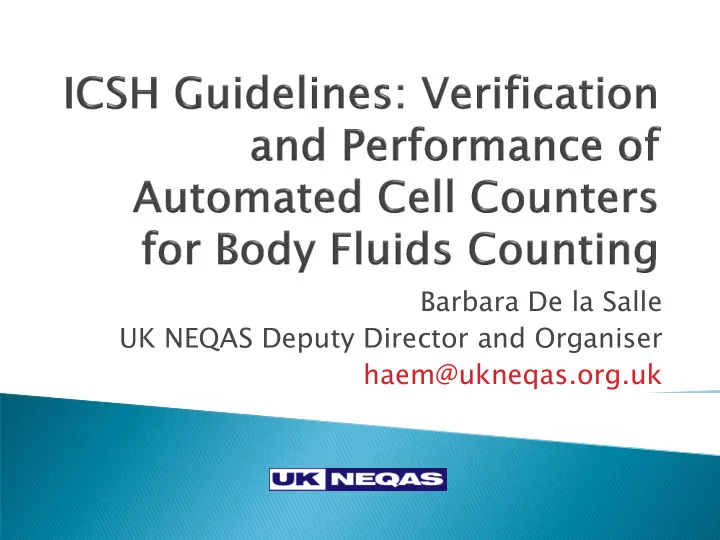

Barbara De la Salle UK NEQAS Deputy Director and Organiser haem@ukneqas.org.uk
Types of fluids: ◦ Cerebrospinal fluid ◦ Serous fluids (ascitic, pleural, pericardial) ◦ Synovial fluid Manual counting: ◦ Labour intensive ◦ May be inaccurate and imprecise ◦ Requires high level of expertise Body fluid counting available on many fully automated cell counters
Patterns of Practice Questionnaire Analyzers Fluids Parameters reported Beckman Coulter LH 750/780 Serous, synovial, CSF WBC, RBC Beckman Coulter DxH 800 Serous, synovial, CSF TNC, RBC Sysmex XE 2100, XT Serous, synovial, CSF WBC, RBC 1800i/2000i , Sysmex XT-4000 and Serous, synovial, CSF BF Mode :WBC-BF , TC-BF, RBC-BF, 2 part diff (mononuclear/ XE-5000 polymorphonuclear Siemens Advia 2120, 2120i Peritoneal, pleural, and TNC, RBC peritoneal dialysate: Iris iQ200 All fluids Nucleated count, RBC
Numerous articles on the use of automated body fluid counts ◦ Verification may be incomplete ◦ Performance specifications lacking Patterns of practice questionnaire ICSH WG for the preparation of guidelines
Distributed to participants: QMP-LS (Ontario) 130 CAP (United States) 1042 UK NEQAS (H) 680 JSLH (Japan) 273 Objectives: Whether laboratories used automated counters for CSF and other body fluid counts How the performance specifications had been determined
1200 1000 800 N Responses 600 BFL counts 400 CSF counts 200 0 QMPLS CAP UK NEQAS (H) JSLH
140 120 100 QMPLS 80 CAP 60 UK NEQAS (H) JSLH 40 20 0 1-10 11-20 21-40 41-80 81-100 >100
80 70 60 50 QMPLS CAP 40 UK NEQAS (H) 30 JSLH 20 10 0 1-10 11-20 21-40 41-80 81-100 >100
Validation and verification of automated systems ◦ Manufacturer’s statement of intended use ◦ Specimen handling ◦ Performance specifications Automated analysis of body fluids ◦ Procedures ◦ Units of measurement Quality Control
Statement that indicates the type of body fluids for which the analyser has been validated Laboratory must verify the manufacturer’s claims ◦ Full verification at one site ◦ Transference verification at other analysers in the same network If the laboratory intends to use the instrument beyond the manufacturer’s scope, a full validation will be required
Pre-analytical variables ◦ Sample container ◦ Storage conditions ◦ Transport conditions Sample stability ◦ Cellular deterioration ◦ Bacterial contamination ◦ Correlation studies between methods should be within 2 hours of each other
To provide evidence that the analyser produces reliable results Objectives are the responsibility of the laboratory Performance should be verified for each type of fluid to be counted Peripheral blood specimens should not be used Limited sample numbers may be a problem ◦ Integrate into daily testing routine ◦ Minimum of 40 recommended
Accuracy ◦ Split sample testing (40 samples recommended) OR ◦ Recovery of expected values from reference materials or commercial controls Precision ◦ 2 or more concentrations ◦ 10 replicates (minimum 5) ◦ May use a commercial control Patient correlation ◦ 40 samples advised
Carryover Lower limits of detection ◦ Limit of blank (LOB) ◦ Limit of detection (LOD) ◦ Limit of quantitation (LOQ) LOB < LOD ≤ LOQ Interfering substances ◦ Dependent on the patient population Analytical Measurement Range, Linearity ◦ Defined by manufacturer, verified by laboratory
Pre-analytical variables ◦ Stability, transport, contamination Pre-treatment of samples, ◦ e.g. Hyaluronidase treatment of synovial fluid ◦ As stated in manufacturer’s statement Background counts ◦ Equal to or less than lower limit of blank
Spurious results ◦ Debris, cell clumps ◦ Irretrievable samples ◦ Impact on accuracy of results Results outside the reportable range ◦ Results that exceed upper or lower limits of the reporting range Units of measure ◦ As for full blood count To avoid confusion for requesting clinician To avoid use of additional calculation steps
Internal Quality Control ◦ Commercial controls available ◦ Use is advised if the body fluids are run in a different mode from whole blood ◦ Differential count External Quality Assessment ◦ EQA provider scheme if available QMPLS (17%), CAP (94%), UK NEQAS (2%), JSLH (0%) ◦ Blind testing ◦ Interlaboratory exchange of samples
Gini Bourner and co-authors Szu-Hee Lee, Vice Chair of ICSH Terry Fawcett and Carol Briggs, ICSH
Recommend
More recommend